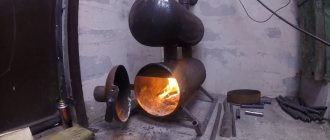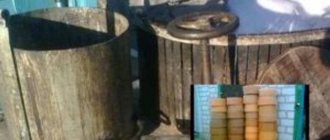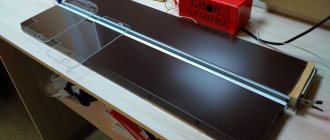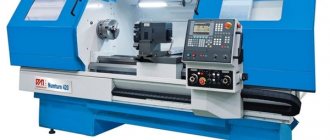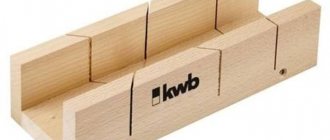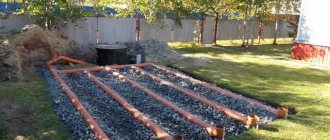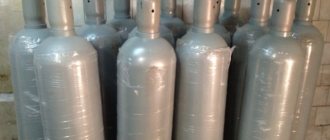Design
The Bubafonya long-burning stove includes the following components:
- Frame. The main element of the device, usually shaped like a cylinder. It is most often made from cylinders, barrels, large fire extinguishers, thick welded pipes, etc.
- A chimney through which combustion products are discharged. The material for its manufacture is usually a metal pipe with a diameter of 110-250 mm. It is fixed by welding to the upper part of the furnace.
- Piston. Ribs are welded onto the lower part of the metal circle: the air duct pipe is fixed in its central part. Due to the ribs, an additional layer of air is created that separates the fuel and the piston. This makes the smoldering process more efficient and stimulates the active release of pyrolysis gases.
- Regulator. Thanks to this valve, oxygen is supplied inside the firebox.
- Lid. It has holes for the air duct, forming, in combination with the piston, a secondary combustion chamber. Inside this compartment combustion of pyrolysis gases occurs.
How to make a low-power pyrolysis oven?
The drawing of the pyrolysis furnace is quite approximate
Despite the relative complexity of the design of pyrolysis furnaces, you can make such a heating device yourself. Options for making the unit from brick or from a gas cylinder are quite common, but the most aesthetically pleasing and efficient in operation is a design made from sheet metal.
Pyrolysis furnaces with low power (up to 25 kW) are excellent for country houses, garages, greenhouses and any premises not exceeding 100 m2 in area. This design differs from a conventional pyrolysis furnace in the following features:
- Does not connect to the heating system.
- There is no need to install a smoke exhauster, since in this case the combustion chamber is simply located above the gasification chamber. This creates natural traction.
- Due to the fact that the design is not automated, it is necessary to periodically adjust the combustion mode and monitor the operation of the equipment.
Construction of a low-power pyrolysis boiler
The instructions for making such a stove include several steps:
- According to the diagram, the structure body is welded from heat-resistant steel, in which holes are provided for the ash pan door and the combustion chamber. In this case, the combustion chamber should be located above the ash pan, separated from it by a cast-iron grate.
- The gas combustion chamber is located exactly above the firebox. Between them there is a cut-off plate, which is made of heat-resistant steel. The firebox must have a special channel through which air will be supplied with the possibility of shutting it off using a special damper.
- The same sheet metal is used to make the doors, which is additionally reinforced with a corner. Doors must be locked.
- The inside of the furnace chamber should be lined with fireclay bricks, which will not only protect the structure from burning out, but will also contribute to better heat distribution.
- The chimney should be made of a heat-insulated pipe. To regulate the draft in the design, a gate is provided.
Testing a homemade pyrolysis boiler
Strengths and weaknesses of Bubafoni
The pyrolysis stove has a number of positive qualities:
- Simplicity of design. Having welding skills and experience working with metal, building a stove will not be difficult.
- Universalism. Bubafonya is very unpretentious in terms of fuel: you can throw firewood, coal, sawdust, chips and other types of wood waste into it. The stove also copes well with pellets – inexpensive, environmentally friendly granules.
- Duration of work. The time it takes for one stack of firewood to burn out is almost a day: during this time, the stove regularly generates heat. This indicator may vary depending on the modification of the device, the volume of its firebox, the oxygen circulation rate, etc.
It is also worth mentioning the main disadvantages of Bubafoni:
- Low efficiency. The reason for this is uneven heating of the device body with sufficiently low heat transfer. More “advanced” pyrolysis furnaces are much more efficient in this regard: their efficiency often exceeds 90%.
- Inconvenient to clean. There is no ash pan as such in the design, so the remaining combustion products are removed through the top. Some modifications of the stove are equipped with a door at the bottom, which facilitates the procedure for removing ash and ash.
- Low aesthetics. The appearance of Bubafoni can hardly be called beautiful, so it is mainly used for heating utility rooms.
Range of gas stoves on the market
Today you can buy similar equipment for a bathhouse to suit any request. A Russian company from Novosibirsk, which produces heating units under the Teplodar brand, has worthily declared itself in the domestic and foreign markets with high-quality certified products that meet international standards. The great popularity of gas stoves for baths "Teplodar" is caused by their ability to quickly heat up and high efficiency. Thanks to the special design of the stove, the steam room is evenly heated and filled with high-quality steam.
The popularity of Termofor gas units, which are also installed in bathhouses, has also been deserved.
The first thing that attracts the consumer’s attention to such products is their rather original appearance. In their reviews of the Termofor gas bath stove, numerous fans note ease of use, high efficiency and excellent performance characteristics
Such a stove fits harmoniously into the interior of any bathhouse, adding special comfort to the room and creating a warm atmosphere. All of its internal technical components are hidden behind the translucent glass on the device's door. The price of a gas stove for a Termofor bath ranges between 10-12 thousand rubles.
The main competition for the products of domestic companies is the German gas furnace Kusatek. This device for heating baths has many advantages. These are, first of all, compactness, which simplifies installation, ease of use and rapid heating, ensuring the achievement of the optimal temperature in a short time. Adjustment of operating modes is achieved by slightly turning the valve. There is no need to remove ash from the stove, since there is simply none. In addition, the internal surface of the device does not require regular cleaning.
German products are distinguished by a high degree of safety, which is why manufacturers confidently recommend installing such a stove in bathhouses. The risk of emergency situations is also eliminated due to the built-in control system, which is responsible for the quality of combustion and fuel pressure indicators.
The main advantages of pyrolysis ovens
- High efficiency - from 90% or more.
- Fuel efficiency - one bookmark is enough for 12-24 hours.
- Modern models of factory-produced pyrope stoves operate on one fuel fill for more than 48 hours.
- Minimum human intervention, simplified operation. Night shifts are excluded.
- From an environmental point of view, the fewer combustion products released into the atmosphere, the better. A pyrolysis oven produces a minimum of carbon monoxide and particulate matter. Almost all CO burns out.
- If you have competent drawings for making a pyrope stove with your own hands and high-quality, precise execution, it is possible to obtain a unit that operates with almost complete combustion of dry fuel. There is very little ash and soot, everything burns without a residue, and there is no need to clean the stove and chimney.
- You can use cheap fuel - dried wood waste, light plant biomass, leaves, branches, straw, etc.
Fuel requirements
Wood fuel for solid fuel boilers is grouped by type: homogeneous and mixed. The admixture of other types of wood in the first category should not exceed 5% of the total cubic capacity of the batch. Firewood is further divided by humidity: dry up to 25%, semi-dry from 25 to 34% and wet over 35%.
Firewood that has been stored in a warehouse for more than 12 months after harvesting is considered dry. Semi-dry timber is spring-harvested timber with a shelf life of at least 6 months.
For solid fuel boilers to operate, it is necessary that the firewood be of a dry category, this is due to the fact that in pyrolysis and long-burning devices operating at low combustion temperatures, wet firewood intensively releases moisture, which accumulates in the lower part of the firebox, combining with sulfur and nitrogen oxides .
Thus, it turns into acid, which corrodes the walls of the combustion chamber and welding seams. Through cracks in the latter, carbon monoxide and aggressive acid can enter the room.
Pancake thickness
This value is in inverse proportion to the internal diameter D. It is necessary to achieve optimal piston pressure on the fuel filler. If the pressure is insufficient, this will lead to a decrease in the reverse action coefficient. As a result, the firebox may backfire with further smoke escaping through the chimney. If the piston is very heavy, this will significantly reduce the air gap necessary for high-quality combustion: as a result, the flame will die out.
The relationship between the internal diameter and thickness of the pancakes is approximately as follows:
- 30 cm – 6-10 mm.
- 40 cm – 6-8 mm.
- 60 cm – 4-6 mm.
- 80 cm – 2.5-4 mm.
Homemade pyrolysis oven from a gas cylinder
Design and operating principle of a gas cylinder stove.
You can make a pyrolysis oven with your own hands according to the drawing from an ordinary gas cylinder; it is also called the Bubafonya oven. Pyrolysis is the separation of organics from inorganics in the absence or deficiency of oxygen. During pyrolysis combustion, temperatures up to 500 degrees are reached. This is a necessary condition for the released pyrolysis gases from wood to burn out.
A pyrolysis furnace from a gas cylinder can operate on any solid fuel, and the fuel moisture level can reach 70%. The cylinders are made of ferrous metal, 3–4 mm thick. The upper part is made in the form of a dome and welded to a cylindrical base. Let's consider what manipulations need to be carried out to make a pyrolysis oven from a gas cylinder:
- cut off the upper convex part;
- in its central part we make a hole for the air duct;
- in the upper part of the conical body we make a hole for the smoke exhaust;
- we manufacture a gas divider with a pipe for supplying oxygen;
- We weld the chimney.
In principle, a homemade pyrolysis oven from a cylinder has a fairly simple design. In your work you may encounter various nuances.
Gas diffuser at the end of the air supply pipe.
The hole in the lid should almost coincide with the diameter of the air supply pipe, and the latter should move easily. The diameter of the gas divider must also be matched to the size of the tank. At the bottom of the gas divider, ribs are welded to direct gas flows. It is better to make them curved so that the flow swirls. Remember, the fewer extra gaps, the higher the efficiency of the unit.
To protect yourself, before starting cutting, you need to fill the cylinder to the top with water, in case gas vapor remains inside. Even if there was liquid in the cylinder before, and there are definitely no gas vapors, a characteristic smell of propane may appear during cutting. Don't worry, it's the additives that are added to the gas that smell. They tend to settle on the inner walls. Additives are a necessary warning measure, since the gas itself has no odor.
The operating principle of a homemade pyrolysis oven from a cylinder:
- Fuel is placed in a cylindrical tank and ignited;
- a pipe with a gas divider at the end is installed on top (the latter should press the fuel);
- the lid is put on top;
- combustion occurs from top to bottom; as the fuel burns out, the pipe with the gas divider lowers.
A feature of this fuel combustion method is the minimum amount of smoke and soot. There is really very little ash. After the first burning, a sharp smell will appear - this is the burning paint that covers the cylinder. There is no point in removing it mechanically, as it is ineffective. It’s easier to burn out everything unnecessary by testing kindling.
To make long-burning pyrolysis stoves with your own hands, you will need the following equipment:
- Bulgarian;
- hammer;
- pliers or pliers;
- welding machine.
To carefully cut a round hole with a grinder in a blank for a pyrolysis oven from a gas cylinder with your own hands, you need to take a small, already erased circle and make a 1 mm indentation along the cutting line. Then, using a large, new circle, cut a square in the center of the marked hole and make slits from it to the edges with an indentation of 1–2 cm, like the petals of a flower. Then the petals are bent inward with a hammer. The bend line will run exactly along the intended perimeter with a depth of 1 mm. The petals can then be broken off with pliers.
As a result, we get a neat hole. If you immediately use a large circle, then the cuts will inevitably go beyond the boundaries of the markings. After this they will need to be brewed. As you know, no welding seam can compare in strength to solid metal.
You can read about how to lay heating pipes in the floor here.
Gas cylinder for pyrolysis furnace
It is not difficult to make a pyrolysis oven from a gas cylinder. What needs to be done for this.
Pyrolysis stove from a cylinder
First of all, inside the cylinder you need to make partitions for the afterburning chamber. To do this, you can cut circles from sheet iron with a diameter equal to the inner diameter of the cylinder. On each circle you need to cut out a segment. The end result should be more than a semicircle. The resulting parts are installed inside the tank, where they are electric welded around the perimeter
It is very important to install the cut circles correctly. It is necessary to carry out the installation so that the space free from the cut-off element is opposite exactly the same, only different cut-off circle
That is, you should get a multi-stage chamber assembled from these circles of partitions, which, when assembled into one system, will form a coil. Along it, pyrolysis gases will rise from the firebox to the chimney. Here they will be enriched with oxygen and burned completely. Be sure to make several small holes with a diameter of 3-5 mm in the wall of the cylinder opposite the first floor of the afterburning chamber. Holes are made with a drill and drill. The end of the created afterburning chamber channel is connected to the outlet pipe, which will become the beginning of the chimney. Therefore, a hole is made on the side or top of the cylinder for the pipe, and it is welded on the outside. As in any furnace, a firebox must be formed in a pyrolysis oven. To do this, a rectangular hole is made in the cylinder for the door. Fuel will be loaded through it. A grate is installed just below the hole, which can be made from the same metal sheet in which the holes must be drilled. You can make it from reinforcement in the form of a mesh. Below the door, on the same side where it will be installed, you need to make several holes to supply primary air.
This design makes it possible to ignite from above the fuel. Air will penetrate through the mass of stacked fuel briquettes and enter the smoldering zone. There will not be very much of it, which will prevent the fuel from igniting at full strength. By the way, sawdust, finely chopped stems or leaves, preferably pressed, fine coal, can be used as fuel in pyrolysis furnaces. Today, manufacturers of pyrolysis boilers offer their own fuel for them, which is made from any plant materials. They are pressed into small granules called pellets.
Pyrolysis stove made from a gas cylinder with a press
A simpler design of a pyrolysis-type stove can be made from a gas cylinder.
- The upper semicircular cap of the cylinder is cut off.
- Part of the sidewall is cut off for the hole for the firebox.
- The grate is installed.
- A pancake with a diameter slightly smaller than the inner diameter of the cylinder is cut out of a metal sheet.
- A hole is made in the pancake for the chimney pipe, which is welded to it.
- This structure must be made heavier, for which four pieces of channel are welded on its lower side. In this case, the chimney opening should not be closed.
- A hole for the chimney is also made in the cut-out cylinder cap.
- The door is hung.
- Small holes are made below the firebox.
Scheme of operation of a pyrolysis furnace from a gas cylinder
The oven is ready, you can load it. More than half of the resulting space is loaded. Ignition can be done from below or from above. A press made of a metal pancake reinforced with channels is installed on top. Its main task is to press the fuel to the combustion (smoldering) zone, while a space formed by channels remains between the walls of the press and the surface of the laid fuel. When burning fuel, the press will lower, leaving the gap the same during the entire process of operation of the pyrolysis furnace.
There is also a gap between the edges of the pancake and the walls of the cylinder, through which carbon monoxide enters the afterburning zone formed by the furnace lid and the upper plane of the press. Typically, such a unit is called a long-burning stove. As practice shows, one bookmark is enough for 6-10 hours, depending on the volume of the combustion chamber.
Lachinyan pyrolysis furnace
How to assemble a structure with a water jacket
The manufacture of the chimney is carried out in the following sequence of operations:
- Carefully cut the balloon at the top. The resulting cap is subsequently used to make a lid for the boiler.
- The bottom of the cylinder is equipped with homemade legs. Each of them must be exactly level before fixing.
The piston is constructed in three stages:
- A steel circle is cut out: in cross section it should be approximately 35-45 mm smaller than the internal diameter of the cylinder. Thanks to the side gaps, pyrolysis gases will leak into the secondary chamber without interference. A hole is made in the center of the circle for the air duct: this pipe should be inserted into it quite tightly.
- Next, the metal circle and pipe are welded to each other.
- A piece of channel is welded on top of the piston base.
To make a furnace lid, you can use the upper cut part of the cylinder. On its surface, markings are applied for the air duct pipe with a fixed supply piston. In this case, it is necessary to provide a certain margin for the free movement of the pipe. Cutting is done along the drawn lines. On the side, the homemade lid is decorated with handles, for which fittings bent in a vice are used. Now you can begin installing the chimney at the top of the improvised pyrolysis oven. Using a grinder, a cutout is made for the pipe blank: welding is also used to fasten the parts.
At this point, the main part of the work on the construction of Bubafoni is considered completed: it can be put into operation. It is advisable to install the stove on a pre-arranged foundation.
Making a boiler from a propane cylinder with your own hands
According to user reviews, such a solid fuel boiler is considered a very economical and efficient device, although it is not double-circuit and operates without forced pressurization. This is explained by the fact that the quality of any boiler is largely determined by the configuration of the firebox.
The combustion chamber, impeccable in almost all respects, has a circular cross-section. There is enough video and photographic material on the Internet to choose a decent model for a private home.
Homemade boiler. Photo source: https://www.youtube.com/watch?v=2YdZppaSALo
Of course, a novice craftsman will not be able to do this, but home craftsmen who have skills in working with welding and plumbing tools will be able to do it, of course, provided that fire safety requirements are compulsorily met.
It should be admitted that there are no recommendations for legalizing such devices, and the fire safety requirements for them are very strict. Here the owner of the premises will have to make his own decision about installing such a heater.
Calculation of parameters: drawings and recommendations
After the user selects the model he needs, he will need to download a drawing from the network to complete the design. Then a 50-liter propane cylinder is selected, and it must be all-metal.
Main parameters and features of boiler manufacturing:
- The chimney is made of a pipe with a diameter of 100-125 mm and a wall thickness of 4 mm.
- The location of the chimney should be vertical or slightly offset, installed in the side wall, at the level of the lower fuel combustion.
- The firebox is loaded from above; a lid with handles is made for this purpose.
- The ash chamber is equipped with doors for fire protection purposes, used to regulate the air supply.
- The grate is a factory-made cast iron grate, installed to maintain burning wood and supply air to the combustion zone.
- A heat exchanger made of steel sheet in the form of a “water jacket” is placed along the chimney.
Required materials and tools
In order to connect a gas boiler for heating from a gas cylinder with a water circuit from a gas cylinder you will need:
- Large gas cylinder.
- Pipe for chimney.
- Sheet steel for making a heat exchanger, ash chamber doors.
- Fittings for coolant outlet inlet and connection of primary temperature and pressure sensors.
- Metal rod for handles on the top cover.
- Hinges for the oven door.
- Temperature and pressure sensors.
- Asbestos cord for sealing the lid and door, a bowl for preparing the sealing solution.
- Bulgarian.
- Welding machine.
- Set of locksmith tools.
Step-by-step instruction
Photo source: https://www.youtube.com/watch?v=2YdZppaSALo
Before you start working with a propane cylinder, you need to make sure that it is not dangerous due to liquefied gas residues. It is better if this cylinder is pre-prepared at the repair site of the city gas company, where there are specialists who know how to properly work with such explosive equipment. Otherwise, the cylinder in the open air must undergo certain processing:
- Open the valve, turn the cylinder upside down and wait until the liquefied gas completely flows out of it.
- Unscrew the valve from the cylinder.
- Again they wait until the gas finally comes out.
- Fill the gas cylinder with water for a day so that the water completely displaces the remaining gas.
- The next day, the water is drained, after which it will be possible to carry out welding and plumbing work on it.
Do-it-yourself gas boiler for heating from a gas cylinder, execution algorithm:
- Cut off the top of the cylinder, sand the edges, making them even.
Photo source: https://www.youtube.com/watch?v=2YdZppaSALo - Firewood is loaded through the top, so the top cover is made and seated using asbestos cord.
- Make a door for the ash chamber and the blower using an angle grinder.
- Drill a hole for the latch.
- Use an angle grinder to make the hole for the chimney.
- Install a chimney.
- An external mini heat exchanger, such as a water jacket, is installed on it.
- Install a digital thermometer on the heat exchanger to control the temperature in the tank.
- Install a safety valve to protect the system from overpressure
- All joints are sealed with asbestos cord.
- Install mounting feet for stable placement above floor level.
Pyrolysis oven made from cans
Camping stove made from tin cans (bottom view).
Who needs a pyrolysis oven made from cans? Obviously, a person who spends a lot of time in nature. These are tourists, fishermen, hunters and travelers. Considering the fact that factory models are quite expensive and weigh a little more than 300 grams, it is best to start making them yourself. Let us immediately note that for work you will need:
- metal scissors;
- drill.
If you can still use a knife instead of metal scissors, then nothing can replace a drill. Therefore, it is hardly possible to make this device in the field. And there’s no need for this; it’s easier to heat up everything you need over a regular fire. As they say: “Get your sleigh ready in the summer.” In order to make a simple pyrolysis oven with your own hands from cans, you will need just two cans of different diameters. No other materials are needed. Sequence of work:
- in a thicker jar, cut the bottom to the diameter of the thinner jar. The latter should fit very tightly;
- in a thin jar we make holes along the top and bottom edges, as well as in the bottom;
- in a thick jar we make holes only along the top edge, where we did not cut a hole;
- connect two banks. The small one is inserted into the cut hole in the large jar until it stops.
The drilled holes must be wide enough to provide good traction. After you have succeeded in making a pyrolysis oven, all that remains is to check the product. Place it on the ground and put small sticks and paper inside. Since this device is used in field conditions, it is very likely that it will have to be lit with a flint. Matches and paper may get wet. What to do in this case?
A useful life hack for tourists is tinder made from a cotton pad. Tinder is a means of starting a fire. To make waterproof tinder from a cotton pad, simply dip it in melted paraffin. This disc repels moisture and is easily ignited with both matches and flint. To ignite it using only sparks, the cotton wool needs to be torn into small pieces. Once the disk has flared up, it can only be extinguished with water; gusts of wind will not extinguish it.
Read how to choose pipes for heating boilers here.
DIY pyrolysis oven
Those who own a country house, a bathhouse, a country house, or simply want to heat their home in a natural, inexpensive way will undoubtedly like a pyrolysis stove.
You say: “What, for example, is worse than a fireplace or a stone stove?”
Of course, stone stoves are very romantic and beautiful. However, in order to install such a structure in a house, you will need quite a lot of space, with a foundation prepared for it. Another disadvantage of fireplaces and heaters is that to maintain their combustion, you need to continuously add an impressive amount of kindling material.
Therefore, the most convenient option for accessible heat in a bathhouse or home is a pyrolysis oven.
Of course, such a stove has its advantages and some disadvantages, the latter, however, are quite insignificant.
Advantages of a pyrolysis oven.
- Very economical fuel consumption. This is achieved due to the fact that such a stove operates not only on fuel, but also on gases released during its combustion. For this property, the pyrolysis furnace received a “second name” - a gas generator.
- Almost any material can be used as fuel for the gas generator: from wood waste and old magazines, to recycled engine oil and plastic.
- Minimum amount of soot produced. Due to the fact that the pyrolysis furnace processes the materials it has already processed several times, there is practically no residue left in the form of burnt fuel. This is a very environmentally friendly home heating solution.
- High utility rate, up to 80%. Even if your entire house is heated by one steam generator, you can wear one T-shirt in all rooms, even in the most severe frosts.
- Easy to control the oven system. Without a doubt, any household member can cope with the principle of controlling this equipment. Moreover, it does not require close attention; you just need to set the heating power and occasionally load fuel.
- You don’t have to spend money on fuel or think about where to throw away household waste without harming the environment. Your waste is the fuel for the pyrolysis furnace.
Although this alternative type of heating has many advantages, of course, it is not without several disadvantages.
- If you buy a ready-made boiler in specialized stores, it will cost you a pretty penny.
- Fuel that is too wet cannot be used in any way for such a stove.
- The gas generator must be permanently connected to the electrical network.
As you can see, in the lists we have given, pyrolysis furnaces still have more advantages than disadvantages.
Features of a long-burning stove
The first step is to understand what happens when wood burns. For a flame to appear, the temperature of the wood must be brought to approximately +150 degrees, using an external heating source. Usually, a piece of paper lit from an ordinary match is enough for this. After this, the process of slow charring of the material begins, which, after reaching +250 degrees, begins to decompose into simple chemical elements. The white smoke that appears when a flame is ignited includes gas and water vapor: they are emitted by heated wood. Ignition of the released gaseous components is observed when heating reaches +300 degrees: as a result of this, the thermochemical reaction is significantly accelerated.
The breakdown of organic matter into simple elements is called pyrolysis. Practice shows that during the combustion of wood, part of the energy potential inherent in it remains unused. This is reflected in a significant amount of waste remaining after the flame goes out. In pyrolysis furnaces, fuel is used much more efficiently, which is achieved by separate combustion of gases released during fuel combustion. At the same time, the rate of smoldering of the wood itself is very low, which helps to increase the operating time of the stove on one stack. The Bubafonya stove, which is a type of pyrolysis heater, guarantees almost complete combustion of all fuel.
Types of long-burning stoves
Options for furnaces of this type are classified depending on the material, method of operation and method of heat transfer. The designs differ in the type of traction and the relative position of the internal chambers. Thus, stoves are made of metal or brick.
Table: classification of pyrolysis furnaces
| material | internal structure | application |
| metal | potbelly stove | heating of residential and non-residential premises |
| for baths and saunas | ||
| cooking | ||
| for barbecue (outdoor) | ||
| Buleryan stove | heating of residential and non-residential premises | |
| Bubafonya stove | heating of non-residential premises | |
| waste oil oven | heating of non-residential premises | |
| brick | Kuznetsov furnace | heating of living space |
| for a bath | ||
| cooking |
Photo gallery: variety of heating units
Based on the method of heat transfer, the units are divided into models:
- with a water heating circuit;
- variability in the placement of heat exchangers (combustion and smoldering chambers are located in different orders). If the firebox is located at the top and the afterburning chamber is at the bottom, then forced draft is required using smoke exhausters and fans. If, on the contrary, the firebox is located below, then natural draft is triggered.
How to choose a stove option
First decide:
- for what purposes is the stove needed;
- where will she stand;
- what fuel to run on?
When choosing the type of structure to DIY, consider the area and type of space. Depending on the parameters of the heated room, the size and power of the furnace are selected. It is worth considering that brick models are placed in a permanent place for future use, while metal ones are almost all mobile.
A homemade stove must meet the necessary characteristics and be safe to use
When making any furnace model, it is worth calculating the balance between the ratio of oxygen and gas. Therefore, the selection and assembly of any furnace option requires careful calculation of the parameters, power and dimensions of the product.
Structural elements
High-quality steel sheets are used to create rectangular metal structures. In this case, the stove is made with double walls. The space between them is filled with sand or water (water circuit). Metal barrels with thick walls can serve as the basis for making a small oven.
The metal structure can be covered with bricks from the outside (lining) or from the inside of the furnace (lining)
The pyrolysis furnace has two combustion chambers. In one compartment, solid fuel is processed, and in the other, pyrolysis products are mixed with air. When the firebox is located at the top for solid fuel, a grate is placed between the compartments. In metal furnaces, the partitions are hollow plates inside.
A visual representation of air flows during operation of a pyrolysis stove with a firebox in the lower compartment
Charge fans are necessary elements in structures where the gas chamber is located below. With the help of forced draft, gaseous substances move downwards, where the afterburning process begins. Such products also contain smoke exhausters on the exhaust channels.
Forced draft directs the gases to the second part of the furnace, where they are burned (releasing a large amount of heat)
All structural elements are interconnected, ensuring efficient operation of the pyrolysis furnace.
Foundation construction
The foundation for the Bubafonya stove is laid in this way:
- The first step is to dig a square hole. Its approximate dimensions are 150x150 cm, with a depth of 20-30 cm.
- The bottom of the trench is covered with a cushion of crushed stone and filled with concrete solution. A trowel is useful to level its surface. When the filled area has set, it is necessary to check the horizontalness of its surface using a building level. If necessary, additional adjustments are made.
- Refractory bricks are laid in several rows on top of a completely dry concrete base. Usually 2-3 layers are enough.
A little history
The development of the Bubafonya stove is attributed to folk craftsman Afanasy Bubyakin from Kolyma. Subsequently, a new invention was named in his honor. During his experiments, Afanasy relied on the design of the Lithuanian-made Stropuva pyrolysis boiler.
The domestic inventor tried to simplify the design as much as possible so that it could be built with your own hands. This specificity of Bubafoni explains its high popularity. Considering that the material for the manufacture of this device is mainly improvised means, it cannot boast of external aesthetics. The strengths of the stove are its simplicity, efficiency and reliability.
How to increase the efficiency of a pyrolysis furnace
Basically, the efficiency of Bubafoni decreases due to uneven heating of its body; this leads to a deterioration in the efficiency of heat exchange between the device and the surrounding space. There is a fairly simple way to optimize the process using corrugated metal sheet. An improvised jacket for the body is made from it: it is fixed over the cylinder by welding or twisting.
Another popular option for increasing the efficiency of a pyrolysis furnace is the Bubafonya boiler with a water jacket. Most often, the water circuit is made from a metal barrel or box, pouring water into it. By placing red-hot Bubafonya inside the manufactured structure, you can heat the water and let it go inside the heating system. In this way, it is possible to acquire a kind of boiler for heating a large room.
When creating a water jacket, you must take all necessary measures to make it as reliable as possible. If a box is used for these purposes, it must be well welded to avoid leaks. It is advisable to seal all seams with heat-resistant sealant. The recommended thickness of the steel sheet for making a water circuit is at least 3 mm. It is best to close the top of the box with a lid with handles. The Bubafonya long-burning stove with a water jacket can be additionally equipped with a heat exchanger consisting of thin tubes.
There are several useful tips for better and safer operation of a long-burning gas cylinder stove:
- It is best to install the device indoors on a sheet of metal.
- The space around the stove must be cleared of any flammable objects.
- When igniting fuel, it is not recommended to abuse flammable liquid.
- The body of the product gets quite hot, so when servicing the heater you need to wear thick gloves.
- To extinguish the flame, the damper on the air pipe is closed.
- Painting parts of Bubafoni is strictly prohibited.
Recommendations for increasing the efficiency of a homemade stove
How to increase the efficiency of bubafoni? What problem is preventing this heat generator from working to its full potential? One of the problems is that the stove body heats up unevenly. Because of this, we get poor heat exchange in the room. Is it possible to solve this problem? Of course you can. To solve this problem, let's take a sheet of corrugated metal profile. We wrap it around the stove, obtaining a protective “shirt” and spot-weld the profile sheet to the cylinder.
You can find another solution besides welding. It's up to you to decide. By implementing this solution into a finished design, we will obtain a long-burning furnace device that forms rising air currents. Cold air will rise from the bottom of the ribs. After passing along the body of the cylinder, the air will heat up and become hot at the outlet. In addition to this modification, you can do the following.
Cover the entire structure with bricks. This will allow heat to accumulate from the generator, releasing it evenly over the entire area of the building for quite a long time. In addition to the profile sheet, you can use pipe scraps. Profile or regular round pipes are suitable. They are welded around the cylinder body, resulting in an effective design for generating heat with uniform heating.
Oven operation
Before igniting the Bubafoni, it is necessary to remove the welded air duct from inside the housing, first removing the top cap. Wood logs are placed inside the stove in a horizontal position, close to each other. When stacking vertically, some obstacles may arise in the path of the piston movement: this usually happens in cases where the logs are not completely burned. As a result, smoldering in the primary chamber will develop into full-fledged combustion, which seriously impairs the proper functioning of the stove. In this case, firewood is consumed much faster, and smoke begins to seep out of the air duct. When laying logs, it is prohibited to block the area where the chimney is welded.
A layer of chips, sawdust or chopped branches is poured onto the firewood. On top of them you need to put old cloth or paper soaked in kerosene. A piston is installed end-to-end on the fuel filler and a cap is put on. To light firewood, you need to light a piece of rags or paper and throw it inside through the air pipe. Matches are ineffective in this case, since they go out before they can reach the fuel. After lighting the firewood, pause for 15-20 minutes, allowing it to flare up well. When the flame gains strength, the valve on the air pipe should be closed: thus, Bubafonya is transferred to the main operating mode.
(no votes yet)
